![]()
Mon, Nov 15, 2010 | shmuelkatz.com | By Shmuel Katz
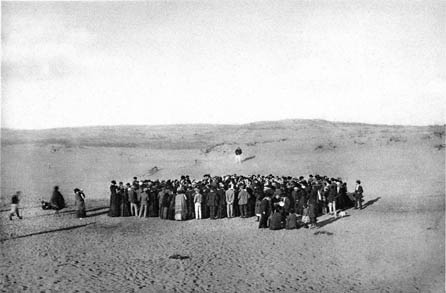
"The meeting founding Tel-Aviv 1908" (source: Avraham Soskin, Tel Aviv, 1926). The lottery of housing plots for the Ahuzat Bayit suburb took place on April 11, 1909. Soskin’s familiar photograph of that event quickly achieved iconic status. Avraham Soskin, on his most famous photograph: “One day, it was in 1909, I was roaming with the camera in one hand and the tripod on my other arm, on my way from a walk through the sand dunes of what is today Tel Aviv to Jaffa. Where the Herzliah Gymnasium once stood I saw a group of people who had assembled for a housing plot lottery. Although I was the only photographer in the area, the organizers hadn’t seen fit to invite me, and it was only by chance that this historic event was immortalized for the next generations.” Avraham Soskin, from a newspaper interview with the journalist Israel Ginzburg (Ha-Boker, November 10, 1961), quoted by Guy Raz in “Soskin’s Theater,” in Avraham Soskin: A Retrospective (2003). (Text source: Stanford university)
Battleground: Fact and Fantasy in Palestine
Beginning To Restore The Land
This article is the fifth chapter from the book “Battleground: Fact and Fantasy in Palestine” written by Shmuel Katz. Yesterday, we published the fourth chapter: The Jewish Presence In Palestine. In the next few days, we will publish the rest of the chapters from this book as part of a series of facts, fantasy and myths concerning Israel, Palestinians and the Middle East. For all the chapters of the book, click Here.
About the book: “A fully documented, dramatic history of the events which shaped the Middle East. Every key problem in the Arab-Israel conflict, every decision is carefully analyzed, from the questionable policies of Britain in 1948 to how the Palestinian refugee problem began. The territory won in the war of 1967, and the terrorist war of attrition is discussed.” (From the intro at ShmuelKatz website). To view the entire book online, go to Shmuelkatz.com. To buy the book, go to Afsi.org.
The land, unloved by its rulers and uncared for by most of its handful of inhabitants, whose silences Lamartine had likened to those of ruined Pompeii, and which Mark Twain had compassionately consigned to the world of dreams, began to come to life again with the blossoming of Jewish restoration in the nineteenth century. Now, instead of having to adapt the pattern of their living, as they had done for centuries, to the frozen mold of Ottoman stagnation, the Jewish immigrants were able to put down their own fresh roots. In the latter half of the nineteenth century, under the pressure and inspiration of the European powers —especially Britain and France, who were supporting, the Sultan’s regime against collapse and his empire against Russian penetration – the Ottoman government introduced a series of reforms. Though imperfectly implemented, they restored a degree of law and order in the country and introduced a revolutionary change in the communal law: Non-Moslems were henceforth to enjoy equality before the law with Moslems.
This reform was bitterly opposed by the Moslems. Non-Moslems had always been second-class citizens under Moslem rule, and Moslems regarded as sacred the inequality in their favor. It was considered natural law that Moslems should be treated as superior beings. During the middle of the century, in protest against the new equality, there were many anti-Christian outbreaks, even massacres, in Syria, Mesopotamia, and Arabia. In Lebanon, French troops came in, and at Jidda, French and British warships had to be sent to intervene on behalf of the victims.
Empty coffers in Constantinople brought about a reform of even more far-reaching consequence: It became possible to buy land from the Sultan. Tracts of land, mostly in Syria, much of it altogether unworked, were bought by a small number of families.
Hence the renewal of Jewish agriculture. Land could be bought from the new landowners. The Turkish government, however, after the brief flicker of hope of cooperation in 1880, became antagonistic to the Jewish restoration. Faced with the organized movement Hovevei Zion (Lovers of Zion), an Eastern European forerunner of the Zionist Organization, preaching and practicing immigration and settlement in Palestine, the Turks imposed a dual prohibition on Jews: They forbade their entry for permanent residence in the country and their purchase of land. The growing number of immigrants thus came into the country as pilgrims, while land was usually acquired by subterfuge and at appreciably higher prices. The ravaged desolation of the land caused many of its non-Jewish inhabitants to leave it, thus bringing on more desolation and denudation. For the returning Jews, it held a challenge and a call for care and love.
The struggle of that generation of pioneers in the 1880s and the two generations that followed them was carried on in a harsh climate, on toughened, treeless soil, while waging an often losing battle with malaria, which came up from the swamps and the undrained rivers, and resisting Bedouins, whose marauding habits persisted even into the twentieth century. The process of reviving the country was to be a long one; it continues to this day. But by 1914, Jewish villages dotted the countryside. As for the towns, the Jews became a majority in Jerusalem by mid-century, then they developed the city outside the walls. They began to give new shape to Haifa, Safed, and Tiberias, and in 1909, expanding the borders of Jaffa, they founded what was to become the first modem all-Hebrew city: Tel-Aviv.
The non-Jewish inhabitants of the country were the passive beneficiaries of these developments. The Ottoman reforms were followed by the opening up of the area to European and American influences. The Christian Churches established schools in Syria and Lebanon, of which both Christians and Moslems took advantage. The new Jewish immigrants directly or indirectly helped to improve their peasant neighbors’ farming methods and to raise their standard of living.
Thus, at the eleventh hour, with the onset of the new century, the long process of flight and disintegration of the non-Jewish population in Palestine was halted. With the founding of the Zionist Organization in 1897 by Theodor Herzl, the longing for the return to Zion achieved a serious and comprehensive political frame of reference for the first time in over seventeen centuries. Herzl’s logical policy of working directly and openly for an arrangement with the Sultan’s government to create the legal instrument for Jewish colonization on a large scale failed in his short lifetime. Equally unsuccessful were later efforts to establish rapport with the revolutionary Young Turks. Zionism’s political progress was blocked, but the physical movement of immigration and restoration continued in the face of endless difficulties erected by the decrepit, backward, and corrupt administration and the physical hardships and perils presented by the ravaged country.
The war that broke out in 1914 provided the most striking confrontation between the passionate Jewish affinity to Eretz Israel and the absence of any awareness of Palestine in the consciousness of the Arab people in general or the Arab community in the country itself.
To the new and young exponents of the Zionist dream, the meaning of Turkey’s entry into the war on the side of Germany was clear from the outset. It was a historic opportunity: Defeat of the Turkish Empire could break its hold on Palestine. The Jews, they decided, must range themselves on the side of Turkey’s enemies, to help bring about the dismemberment that would make possible Jewish restoration. In the result, the Jewish people played a part far beyond its weight and size in winning the war. The Jews had no sovereign power and no national base of operations, they were a collection of minorities scattered over the world, and they were in fact fighting as citizens in all the armies on both sides. Yet out of the vast panorama of the First World War and its carnage, and the range of peoples that took part in it, there emerged the phenomenon of an additional, superimposed contribution, a unique voluntary engagement, and a willing sacrifice that sprang from the Jewish passion for Eretz Israel and a now urgent hunger for independence.
The Zionist effort in its various ramifications was spread far and wide. It revolved primarily around the work of three men: Chaim Weizmann, Zeev Jabotinsky, and Aaron Aaronson. Each independently came to the conclusion that Jewish restoration could be built only on the ruins of the Ottoman Empire. Each in his own way sought to provide Britain and her allies with help to win the war.
The question of taking sides was not simple for the Jewish people at large. Considerable numbers of Jews lived in the German and Austro-Hungarian Empires.
Their condition was tolerable, certainly incomparably better than the state of the Jews in Russia; Tsarist Russia – the ally of Britain and France – was unspeakably, endemically anti-Semitic. In nineteenth- and early-twentieth-century Europe, it played the role that a generation later was filled, more directly and thoroughly and scientifically, and with devastating effect, by Nazi Germany. Not the least of the factors weighing in the United States and in its Jewish community for neutrality in the war, or even for support for Germany, was the deep and widespread disgust for the Russian regime and the knowledge that a victory for the Allies would mean a victory for tsarist tyranny.
Moreover, there was now a substantial Jewish population in Palestine as well as sizable communities in other parts of the Ottoman Empire. All these would be potentially in jeopardy if the Jewish people were to be identified as anti-Turkish. The disadvantages and the dangers of identification with the Allied cause were clear. Fear of Turkish reprisals and hatred of Russia were overcome, however, by a more powerful emotion – the urge to national regeneration.
Under Weizmann’s lead, the Zionists developed a consistent pro-Allied propaganda in the United States. The issue was crucial – no more and no less than bringing influence to bear in the United States for the government to abandon its neutrality and to join the Allies in the war against Germany. This was amplified, as soon as Turkey entered the war, by the campaign launched by Jabotinsky to form a Jewish Legion in the British Army to fight for the liberation of Palestine. Though the idea of a Jewish military unit inevitably met with considerable opposition both from timid and assimilated Jews and from the British, it prevailed in the end. A Jewish auxiliary unit, the Zion Mule Corps, took part in the Gallipoli campaign. Jewish battalions, consisting of volunteers from Britain, the United States, Canada, and Palestine itself, took part in the latter stages of Allenby’s campaign. They played an especially, notable part in the defeat of the Turks on the Jordan River and in driving the Turks out of eastern Palestine (Transjordan).
The Australian general, Sir Edward Chaytor, told the Legionnaires: By your gallant capture of the Umm Es Shert Ford and defeat of the Turkish rearguard I was enabled to push my mounted men over the Jordan and so you contributed materially to the capture of Es Salt and Amman, the cutting of the Hedjaz Railway and the destruction of the Fourth Turkish Army, which helped considerably towards the great victory won at Damascus.
Aaron Aaronson, the only one of the three leaders to live in Palestine at the time, made a major contribution to the conduct of the Allied campaign in Palestine. A brilliant and versatile man, Aaronson by 1914 had won worldwide fame as a scientist, especially as the discoverer of wild wheat. He was chosen by the Turkish government to direct the campaign against the plague of locusts that ravaged the country during the first year of the war. Soon after the war began, Aaronson was afforded details of the extermination in cold blood by the Turks of some two million Armenian subjects of their empire. By this time, the Jews in Palestine were already being subjected to terrorization, despoliation, and deportation. Under the circumstances, it seemed impossible to fight against the Turks. The leaders of the still modest Jewish community bowed their heads to the storm. Aaronson, convinced that a British victory was vital for the Jewish future, organized the Nili group – an intelligence service for the British behind the Turkish lines. He himself managed to find his way to Egypt, where, in addition to directing and maintaining contact with Nili, he became probably the most important adviser at British HQ for the forthcoming invasion of Palestine under the Commander-in-Chief, General Allenby.
Aaronson’s encyclopedic knowledge of the terrain in all its aspects – population, climatic vagaries, water problems, transport problems – was unique. In addition, a stream of essential current military information came from the Nili organization. The price paid by Aaronson’s group was high. In an attempt to reach Egypt overland by way of the Sinai Desert, Aaronson’s chief collaborator, Avshalom Feinberg, was killed by Bedouins. In September 1917, the Turks exposed the Nili network. Two of its leaders, Naaman Belkind and Yosef Lishansky, were hanged in Damascus; many of the others were imprisoned and tortured. Among these was Aaronson’s sister Sarah, who had served as his deputy. During a respite from torture, she succeeded in shooting herself. Literature on Aaronson, who died in a plane crash in 1919, is sparse. See a recent biography by Eliezer Livneh, Aaron Aaronson Ha’ish Uzemano [Aaron Aaaronson, The Man and His Times]. Jerusalem: Mosad Bialik 1969.
The Nili intelligence proved indispensable. British General Gribbon expressed the opinion that in the crucial battle for Beersheba alone, it had saved 30,000 British lives. Even more explicit were Allenby’s own words on Aaronson:
“He was mainly responsible for the formation of my Field Intelligence Organization behind the Turkish lines.”
The significance of that intelligence service was summed up by Sir George Macdonogh, Director of British Military Intelligence, in a professional lecture after the war:
You will remember Lord Allenby’s great campaign in Palestine in that year and you may have wondered at the audacity of his operations. It is true that in war you cannot expect a really great success unless you are prepared to take risks, but these risks must be reasonable ones. To the uninitiated it may sometimes have appeared that Lord Allenby’s were not reasonable. That however was not the case because Lord Allenby knew from his Intelligence every disposition and movement of the enemy. Every one of his opponent’s cards was known to him, and he was consequently able to play his own hand with the most perfect assurance.
In those circumstances victory was certain. The Nili underground was surrounded by an atmosphere of perpetual terrorization by the Turkish authorities. From the very beginning of the war the governor, Djemal Pasha, had treated the Jews of Palestine as a potential enemy, since he realized that to the Jews the Turks were the alien occupiers of their country and that Zionism was now an active force in the world.
In response to the practical manifestations of Jewish collaboration with the Allies – the Zion Mule Corps in Gallipoli 1915, the campaign in Britain to create Jewish regiments, the Zionist pro-Allied campaign in the United States and elsewhere – Djemal became ever more fierce in his repressions. Police brutality, economic discrimination, arbitrary arrests, and deportations were the constant companions of the Jews throughout the war. Of a population estimated at some 90,000 at its outbreak, less than 60,000 remained when it ended.
The Arabs living in Palestine did not protest Turkish overlordship. When war came, they fought to perpetuate Turkish imperial rule. The Arabs of Palestine made no response to the call of Sherif Hussein of Hejaz, the one zone where Arab action against the Turks developed, and they contributed nothing to even that marginal Arab contribution to the downfall of Turkey. Even when the British forces under Allenby, their path eased and smoothed by the Nili intelligence, finally swept into Palestine, there was no Arab rising behind the lines to help them rout the Turks.
Thus Djemal, commanding the Turkish force which in 1915 made its way through Sinai to attack the British on the Suez Canal, was able in his memoirs to emphasize the spirit of solidarity displayed by the Arab soldiers.
“I can have no greater duty,” he wrote, “than to offer a respectful tribute to these heroes…. In this force, composed of men of Arab and Turkish stock, a fine feeling of brotherly affection prevailed. This first campaign against the Canal was a brilliant revelation of the fact that the majority of the Arabs stood by the Khalifate with heart and soul. The Arabs, who composed the entire 25th division and the whole of the L. of C. Organization, did their duty with the greatest zeal and devotion.”
Even after the defeat of the Turks, the Arabs were unable to hide their feelings. British Col. Richard Meinertzhagen recorded in his diary on December 2, 1917:
The Arabs of Ramleh gave us an amusing incident yesterday which accurately reflects their attitude towards us. A large batch of Turkish prisoners were being marched through the village, but they were not preceded by their British Guard. The Arabs, thinking it was the return of the Turkish Army, turned out in force, yelling with delight and waving Turkish flags. [Middle East Diary, p. 7]
After the war and at the beginning of the British Mandatory regime in Palestine, Arabs, among themselves and in trying to engage the sympathies of the Moslem world, emphasized how loyal they had been to the Turks. Writing to the Mufti of Jerusalem on a visit to India in 1923, the Mufti of Haifa noted:
We found repugnance by every Moslem towards anyone who was called Arab…They took him to be like the Sharif Husain of whom they say that he betrayed Islam…We began to rebut this notion and to show all that Palestine had done in giving total aid to the Turkish army and how she fought to the end.
This attitude and behavior were, in fact, natural and 1ogical. Even in 1914 there were no more than the faintest glimmerings of any Arabic national consciousness. After 1908 – the year of the Young Turkish revolution – an opposition had come into existence in the empire against the Young Turks’ excessive administrative centralization and cultural Turkification. These oppositional groups worked for decentralization and for a recognized status for the Arabic language, but they made no impact on the population: Throughout the area the membership of all the groups totaled 126. Of these, 22 were from Palestine.
There was no sign of anything remotely resembling a national movement, of a sense of nationality, of “ownership” of the country they lived in, of rejection of the Turks. As late as March 1917, T. E. Lawrence – the last person in the world to understate the Arab case – wrote in a confidential report in the Arab Bulletin:
The words Syria and Syrian are foreign terms. Unless he had learnt English or French, the inhabitant of these parts has no words to describe all his country . . . Sham is Arabic for the town of Damascus. An Aleppine always calls himself an Aleppine, a Beyrouti a Beyrouti, and so down to the smallest villages. This verbal poverty indicates a political condition. There is no national feeling. [Secret Despatches, pp. 77-78]
The Arab leaders, before they became involved in the intrigues launched to resist the Jewish restoration, gave unequivocal recognition to the Jewish bond with Palestine and the Jewish right.
The Emir Faisal I, son of Hussein, Sherif of Mecca, who initiated the Arab Revolt, briefly King of Syria and later King of Iraq, signed a treaty with Dr. Chaim Weizmann in February 1919. In this treaty, they outlined the relations between “the Arab state and Palestine.” There was no mention of mutual “recognition” – in the context of the treaty it was superfluous. That an Arab state was about to arise (as it did) was taken for granted. It was equally taken for granted that Palestine was to be a Jewish state.
Before signing the 1919 treaty with Weizmann, Faisal had told Reuter’s Agency:
“Arabs are not jealous of Zionist Jews and intend to give them fair play, and the Zionist Jews have assured the nationalist Arabs of their intention to see that they too have fair play in their respective areas” (London Times, December 12,1918).
What was the Zionist area? In a letter to Felix Frankfurter (March 3, 1919), Faisal wrote:
“We Arabs, especially the educated among us, look with the deepest sympathy on the Zionist Movement. Our delegation here in Paris is fully acquainted with the proposals submitted yesterday by the Zionist Organization to the Peace Conference and we regard them as moderate and proper.”
These proposals had called for the establishment of a Jewish state and specified its boundaries in detail. These took in all of Galilee (including the area up to the Litany River, later torn out of Palestine and transferred to the French zone of interest in Lebanon), the territory east of the Jordan (later torn out of Mandatory Palestine to become finally the Arab Kingdom of Transjordan), and part of the Sinai Peninsula. The treaty itself was couched in simple language: The Arab State and Palestine in all their relations and undertakings shall be controlled by the most cordial goodwill and understanding and to this end Arab and Jewish duly accredited agents shall be established and maintained in the respective territories. In the establishment of the Constitution and Administration of Palestine all such measures shall be adopted as will afford the fullest guarantees for carrying into effect the British Government’s (Balfour) declaration of 2 November 1917.
All necessary measures shall be undertaken to encourage and stimulate immigration of Jews into Palestine on a large scale and as quickly as possible to settle Jewish immigrants upon the land. The treaty further envisaged Jewish aid to the Arab state. The Zionist Organization undertook to place at the disposal of the Arab state a commission of experts to study economic possibilities and to try to obtain economic help.
A year earlier Faisal’s father, Hussein (who in his negotiations with the British on the rewards for his revolt had demanded all the Asian territory ever included in the Moslem Empire, except Turkey, and who had been promised most of it – excepting Palestine), had written or inspired an article in the Mecca newspaper Al Qibla, which is most revealing on the relative affinities of Arabs and Jews to Palestine. It appeared on March 23, 1918, while the war was still in progress, two months after Hussein had been officially informed of the British government’s Balfour Declaration promising the establishment of the Jewish Home in Palestine.
Hussein called upon the Arab population in Palestine to welcome the Jews as brothers and to cooperate with them for the common good.
The resources of the country are still virgin soil and will be developed by the Jewish immigrants. One of the most amazing things until recent times was that the Palestinian used to leave his country, wandering over the high seas in every direction. His native soil could not retain a hold on him, though his ancestors had lived on it for 1,000 years. At the same time we have seen the Jews from foreign countries streaming to Palestine from Russia, Germany, Austria, Spain, America. The cause of causes could not escape those who had the gift of a deeper insight. They knew that the country was for its original sons [abna’ihi-l-asliyin], for all their differences, a sacred and beloved homeland. The return of these exiles [Jaliya] to their homeland will prove materially and spiritually an experimental school for their brethren who are with them in the fields, factories, trades, and in all things connected with toil and labor.
In that same year, the leaders of the Moslem community in Palestine itself had an opportunity to give formal expression to their attitude toward the movement of Jewish restoration and its recognition by the British government. On July 24, 1918, the foundation stones of the Hebrew University were laid on Mount Scopus in Jerusalem. Christian and Moslem notables attended. The religious leader of the Moslems, Kamil el-Husseini, the Mufti of Jerusalem, laid one of the stones and signed the parchment buried under it. There the date was given as the twenty-first year after the first Zionist Congress and the first year of the Balfour Declaration “promising to grant a national home to the Jewish people in Palestine.”
The twilight months of the end of the First World War were a dramatic moment in the history of Eretz Israel. As the 400-year-old Ottoman Empire, crumbling to its fall, released its hold on the country, it brought to a close the long succession of its foreign and – except for the Crusaders – imperial absentee rulers. For nearly two thousand years, though the Jews were powerless to prevent it, no other people had made Palestine its national home. And now Christians and Moslems, whatever resentments they might harbor, however much they might dislike or fear the Jewish return to the land – all now joined in recognition of the title of the Jewish people to be the land’s master.
The myth of an Arab historic claim to the country was born later.
We would like to thank ShmuelKatz.com for providing us with the material for this article. This article is republished with the permission of David Isaac, e-Editor of ShmuelKatz.com. For republishing rights please contact David Isaac directly at David_Isaac@ShmuelKatz.com.
About the author,
Shmuel “Mooki” Katz, born Samuel Katz (9 December 1914 – 9 May 2008) was an Israeli writer, member of the first Knesset, publisher, historian and journalist. He was a member of the first Knesset and is also known for his research on Jewish leader Ze’ev Jabotinsky.
Katz was born in 1914 in South Africa, and in 1930 he joined the Betar movement. In 1936 he immigrated to Mandate Palestine and joined the Irgun. In 1939 he was sent to London by Ze’ev Jabotinsky to speak on issues concerning Palestine. While there he founded the revisionist publication “The Jewish Standard” and was its editor, 1939–1941, and in 1945. In 1946 Katz returned to Mandate Palestine and joined the HQ of the Irgun where he was active in the aspect of foreign relations. He was one of the seven members of the high command of the Irgun, as well as a spokesman of the organization.
In 1948 Katz assisted in the bringing of the ship, Altalena to the shores of Israel. Shmuel Katz was one of the founders of the Herut political party and served as one of its members in the First Knesset. In 1951 he left politics and managed the Karni book publishing firm. He was co-founder of The Land of Israel Movement in 1967, and in 1971 he helped to create Americans for a Safe Israel.
In 1977 Katz became “Adviser to the Prime Minister of Information Abroad” to Menachem Begin. He accompanied Begin on two trips to Washington and was asked to explain some points to President Jimmy Carter. He quit this task on January 5, 1978 because of differences with the Cabinet over peace proposals with Egypt. He refused the high prestige post of UN ambassador. Katz was then active with the Tehiya party for some years and later with Herut – The National Movement after it split away from the ruling Likud. He also has written for the Daily Express and The Jerusalem Post. (source: wikipedia and shmuelkatz.com)



 RSS
RSS

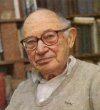


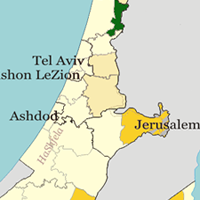
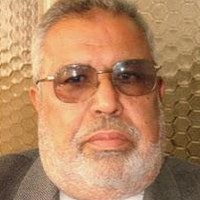
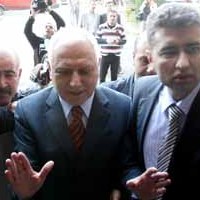




Beginning To Restore the Land | #Israel #Palestine #Balfour #Telaviv http://j.mp/cqRlRL
RT @CrethiPlethi: Beginning To Restore the Land | #Israel #Palestine #Balfour #Telaviv http://j.mp/cqRlRL
[…] Fact and Fantasy in Palestine” written by Shmuel Katz. Yesterday, we published the fifth chapter: Beginning To Restore The Land. In the next few days, we will publish the rest of the chapters from this book as part of a series […]